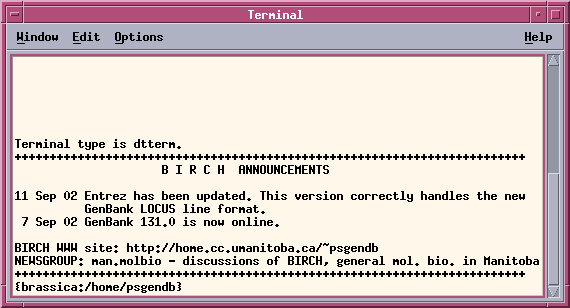
Setting the path and environment variables
No special permission is needed to use BIRCH. It is accessible by anyone with a valid Unix account. However, two things need to be setup in order to use the programs. First, your $PATH must include the directories in which BIRCH executable files are found. Secondly, many of the programs need to know where to find data or configuration files. The locations of these files are specified by environment variables that are automatically set when you login.
All of these processes can be made transparent to the user by running the 'newuser' command. At the command prompt, type
/home/psgendb/admin/newuserThis will add some lines to your .login and .cshrc and .profile files, which contain commands that execute each time you login. (Comparable to AUTOEXEC.BAT in DOS). These commands 1) set your path 2) set your environment variables, 3) set your prompt to display the current working directory and hostname.
Now, logout and login again. When you open a terminal window, it
should now
look similar to this:

Changes to note are the BIRCH ANNOUNCEMENTS, and the new prompt,
which tells the host you are logged into, and the name of the
current directory. At this point you should have full access to
all BIRCH programs and data. YOU ONLY NEED TO DO THIS ONE ONCE!
Every time you log in thereafter, you will automatically have
access to BIRCH programs and databases.
For a more in-depth description of how BIRCH parameters are set,
see the BIRCH
Administrator's
Guide - Key Concepts.
The changes made by the newuser script can be reversed,
eliminating BIRCH access for any user. The user types
/home/psgendb/admin/nobirch
nobirch removes all lines added by newuer to .cshrc, login,
.profile, .bash_profile and .bash_login. They can be used as often
as one wishes to turn BIRCH access on and off.